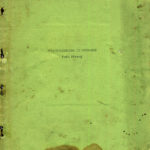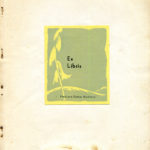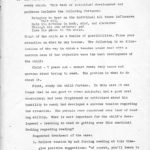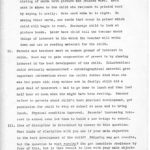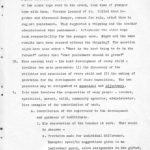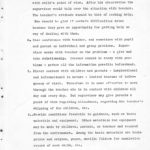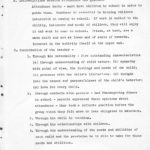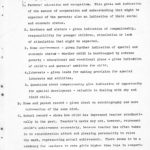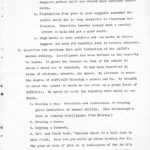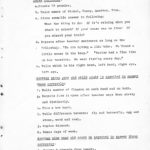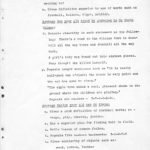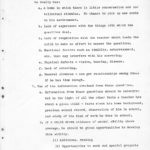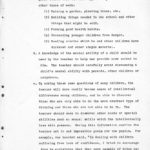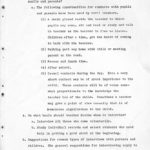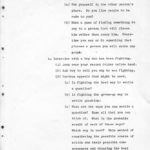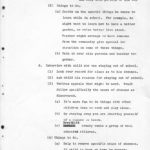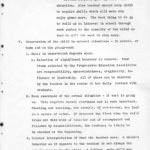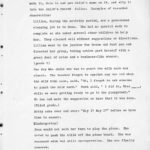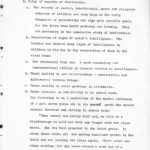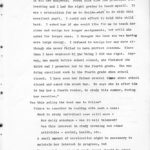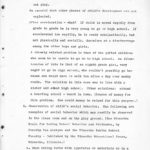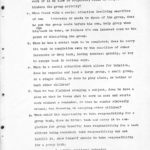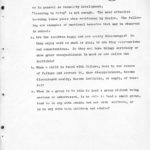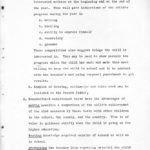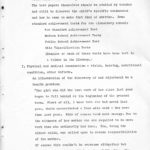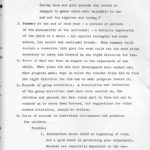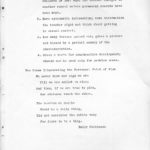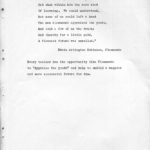Pine Mountain Settlement School
Series 09: BIOGRAPHY Visitor
Series 13: EDUCATION & EDUCATIONAL PROGRAMS
Series 21: RYGI RURAL YOUTH GUIDANCE INSTITUTE
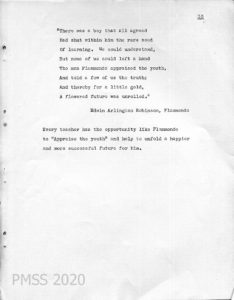
035 Ruth Strang: “Contributions to Guidance.” [strang_ruth_cont_guidance_035.jpg]
RYGI 1936 RUTH STRANG Contributions to Guidance June 1936
TAGS: Publication by Ruth Strang,Contributions to Guidance,Rural Youth Guidance Institute, teaching guide, child development, parent/teacher/child interviews, child discipline, Record-keeping on children, observations of children, tests for children
Contents: RUTH STRANG Contributions to Guidance
Cover [strang_ruth_cont_guidance_cover.jpg]
CONTRIBUTIONS TO GUIDANCE – Ruth Strang
Bookplate [strang_ruth_cont_guidance_ex_libris.jpg]
Ex Libris: Fred and Esther Burkhard
001 [strang_ruth_cont_guidance_001.jpg]
I. Main Points Covered in Class Discussions, June 1936. I. The central task of teaching is the best development of every child. … Think of the child as a bundle of possibilities. Focus your attention on what he may become. … [Provides a case example and suggested treatment of the case].
002 [strang_ruth_cont_guidance_002.jpg]
II. Parents and teachers meet on common ground of interest in child. … [Provides an example].
III. Idea of discipline is determined by answer to this question: What kinds of discipline will you use if your main objective is the best development of the child? [Discussion of the issue a better method to use than “whipping.”]
003 [strang_ruth_cont_guidance_003.jpg]
IV. This central task – the best development of every child – involves two main processes: (1) the discovery of the abilities and capacities of every child and (2) the making of provision for the development of those capacities. The two processes may be designated as appraisal and adjustment.
V. This task involves the cooperation of many people – teacher, specialist, parent, child, community agencies, administrator.
A. Contribution of the supervisor to the development and guidance of individuals. …
004 [strang_ruth_cont_guidance_004.jpg]
[Continued: Supervisor’s contribution.]
005 [strang_ruth_cont_guidance_005.jpg]
B. Interrelations between attendance and guidance. …
C. Contribution of the teacher. …
006 [strang_ruth_cont_guidance_005.jpg]
Records Which Help The Teacher To Understand Individual Children
I. Kinds of records and information supplied by them:
A. Autobiography … [Lists types of information that should be provided].
B. Home and parent records …
C. School record …
007 [strang_ruth_cont_guidance_007.jpg]
D. Questions and problems that give indication of the child’s mental ability. … [Defines “intelligence” and provides examples of tests and questions.]
008 [strang_ruth_cont_guidance_008.jpg]
[Lists the question that an average six, seven and nine-year-old could be expected to answer correctly.]
009 [strang_ruth_cont_guidance_009.jpg]
[Continued: List of questions for an average ten and twelve-year-old.]
010 [strang_ruth_cont_guidance_010.jpg]
[Lists the following:]
6. Things that may prevent a child from showing the ability he really has.
7. Use of the information obtained from these questions.
011 [strang_ruth_cont_guidance_011.jpg]
[Continued: Use of the information obtained from questioning the student.]
012 [strang_ruth_cont_guidance_012.jpg]
E. Interview with child or parent. … [States purposes of the interview and an example of a teacher’s conversation with a parent.]
013 [strang_ruth_cont_guidance_013.jpg]
[Continued: An example of a teacher’s conversation with a parent.]
014 [strang_ruth_cont_guidance_014.jpg]
[Followup comments to the teacher/parent conversation, including the subject of “whipping.” Provides “a number of things that help to make an interview successful.”]
015 [strang_ruth_cont_guidance_015.jpg]
[Continued: List of ways toward a successful teacher/parent interview.]
016 [strang_ruth_cont_guidance_016.jpg]
[Continued: List of ways toward a successful teacher/parent interview: how to “find time and opportunity to talk with individual pupils and parents.” and how to decide whom to interview.]
017 [strang_ruth_cont_guidance_017.jpg]
[Continued: List of ways toward a successful teacher/parent interview.] A very valuable type of information to give in these interviews is specific and accurate stories of others who have made wise choice[s]. …
018 [strang_ruth_cont_guidance_018.jpg]
[Continued: List of ways toward a successful teacher/parent interview. Interview with a child who has been rude.]
019 [strang_ruth_cont_guidance_019.jpg]
[Continued: List of ways toward a successful teacher/parent interview. Interview with a child who has been fighting.]
020 [strang_ruth_cont_guidance_020.jpg]
Breathitt county is getting away from the old days of feuds. …
[Continued: List of ways toward a successful teacher/parent interview. Interview with a child who wishes to leave school.]
021 [strang_ruth_cont_guidance_021.jpg]
[Continued: List of ways toward a successful teacher/parent interview. Interview with a child who was staying out of school.]
022 [strang_ruth_cont_guidance_022.jpg]
F. Observation of the child in natural situations – in school, at home and on the playground. …
023 [strang_ruth_cont_guidance_023.jpg]
[Continued: Covers the correct methods of making and recording observation of the student.]
024 [strang_ruth_cont_guidance_024.jpg]
[Continued: Covers the correct methods of making and recording observation of the student.]
025 [strang_ruth_cont_guidance_025.jpg]
[Continued: Lists the values of keeping records of observation, with example.]
026 [strang_ruth_cont_guidance_026.jpg]
[Continued: Example of keeping records of observation.]
027 [strang_ruth_cont_guidance_027.jpg]
[Continued: Example of keeping records of observation; acceleration; examples of when to observe child’s social behavior.]
028 [strang_ruth_cont_guidance_028.jpg]
[Continued: examples of when to observe child’s social behavior; child’s emotional behavior.]
029 [strang_ruth_cont_guidance_029.jpg]
“Learning by doing” is not enough. The most effective learning takes place when reinforced by desire.
[Continued: examples of how to observe child’s social behavior.]
030 [strang_ruth_cont_guidance_030.jpg]
Note: Page 31 follows 29 in content, since due to a misnumbering there is no page “30”.
031 [strang_ruth_cont_guidance_031.jpg]
G. Samples of children’s work. [Suggestions of samples to file in the record folder include a short composition by the student at beginning and end of the year.]
H. States the values of standardized achievement tests and testing knowledge acquired outside of school.
032 [strang_ruth_cont_guidance_032.jpg]
[Lists “some standard achievement tests for the elementary school.”]
I. Physical and medical examination – vision, hearing, nutritional condition, other defects. … [Provides example.]
033 [strang_ruth_cont_guidance_033.jpg]
J. Summary at the end of each year — a picture or pattern of the personality of the individual – a definite impression of the child as a whole … [including] a tentative life goal …
K. Notes of what was done in regard to the adjustment of the child. …
L. Records of group activities. …
M. Value of records in Individual development and guidance for children. …
034 [strang_ruth_cont_guidance_034.jpg]
Two Poems Illustrating the Personnel (sic) Point of View [Poem by Emily Dickenson]
035 [strang_ruth_cont_guidance_035.jpg]
[Continued: Two Poems Illustrating the Personnel (sic) Point of View. Poem by Edwin Arlington Robinson, Flammonde.]
Every teacher has the opportunity like Flammonde to “Appraise the youth” and help to unfold a happier and more successful future for him.
Gallery: RUTH STRANG Contributions to Guidance
- Ruth Strang: “Contributions to Guidance.” [strang_ruth_cont_guidance_cover.jpg]
- Ruth Strang: “Contributions to Guidance.” [strang_ruth_cont_guidance_ex_libris.jpg]
- 001 Ruth Strang: “Contributions to Guidance.” [strang_ruth_cont_guidance_001.jpg]
- 002 Ruth Strang: “Contributions to Guidance.” [strang_ruth_cont_guidance_002.jpg]
- 003 Ruth Strang: “Contributions to Guidance.” [strang_ruth_cont_guidance_003.jpg]
- 004 Ruth Strang: “Contributions to Guidance.” [strang_ruth_cont_guidance_004.jpg]
- 005 Ruth Strang: “Contributions to Guidance.” [strang_ruth_cont_guidance_005.jpg]
- 006 Ruth Strang: “Contributions to Guidance.” [strang_ruth_cont_guidance_006.jpg]
- 007 Ruth Strang: “Contributions to Guidance.” [strang_ruth_cont_guidance_007.jpg]
- 008 Ruth Strang: “Contributions to Guidance.” [strang_ruth_cont_guidance_008.jpg]
- 009 Ruth Strang: “Contributions to Guidance.” [strang_ruth_cont_guidance_009.jpg]
- 010 Ruth Strang: “Contributions to Guidance.” [strang_ruth_cont_guidance_010.jpg]
- 011 Ruth Strang: “Contributions to Guidance.” [strang_ruth_cont_guidance_011.jpg]
- 012 Ruth Strang: “Contributions to Guidance.” [strang_ruth_cont_guidance_012.jpg]
- 013 Ruth Strang: “Contributions to Guidance.” [strang_ruth_cont_guidance_013.jpg]
- 014 Ruth Strang: “Contributions to Guidance.” [strang_ruth_cont_guidance_014.jpg]
- 015 Ruth Strang: “Contributions to Guidance.” [strang_ruth_cont_guidance_015.jpg]
- 016 Ruth Strang: “Contributions to Guidance.” [strang_ruth_cont_guidance_016.jpg]
- 017 Ruth Strang: “Contributions to Guidance.” [strang_ruth_cont_guidance_017.jpg]
- 018 Ruth Strang: “Contributions to Guidance.” [strang_ruth_cont_guidance_018.jpg]
- 019 Ruth Strang: “Contributions to Guidance.” [strang_ruth_cont_guidance_019.jpg]
- 020 Ruth Strang: “Contributions to Guidance.” [strang_ruth_cont_guidance_020.jpg]
- 021 Ruth Strang: “Contributions to Guidance.” [strang_ruth_cont_guidance_021.jpg]
- 022 Ruth Strang: “Contributions to Guidance.” [strang_ruth_cont_guidance_022.jpg]
- 023 Ruth Strang: “Contributions to Guidance.” [strang_ruth_cont_guidance_023.jpg]
- 024 Ruth Strang: “Contributions to Guidance.” [strang_ruth_cont_guidance_024.jpg]
- 025 Ruth Strang: “Contributions to Guidance.” [strang_ruth_cont_guidance_025.jpg]
- 026 Ruth Strang: “Contributions to Guidance.” [strang_ruth_cont_guidance_026.jpg]
- 027 Ruth Strang: “Contributions to Guidance.” [strang_ruth_cont_guidance_027.jpg]
- 028 Ruth Strang: “Contributions to Guidance.” [strang_ruth_cont_guidance_028.jpg]
- 029 Ruth Strang: “Contributions to Guidance.” [strang_ruth_cont_guidance_0029.jpg]
- 030 Ruth Strang: “Contributions to Guidance.” [strang_ruth_cont_guidance_030.jpg]
- 031 Ruth Strang: “Contributions to Guidance.” [strang_ruth_cont_guidance_031.jpg]
- 032 Ruth Strang: “Contributions to Guidance.” [strang_ruth_cont_guidance_032.jpg]
- 033 Ruth Strang: “Contributions to Guidance.” [strang_ruth_cont_guidance_033.jpg]
- 034 Ruth Strang: “Contributions to Guidance.” [strang_ruth_cont_guidance_034.jpg]
- 035 Ruth Strang: “Contributions to Guidance.” [strang_ruth_cont_guidance_035.jpg]
See Also
RYGI RURAL YOUTH GUIDANCE INSTITUTE
RYGI RURAL YOUTH GUIDANCE INSTITUTE Guide
RUTH STRANG Guidance Institute Leader
Return to
Consultants, Friends, Community, Guests, Visitors Related to PMSS GUIDE
Series 09: COMMUNITY, FRIENDS AND VISITORS RELATED TO PMSS

